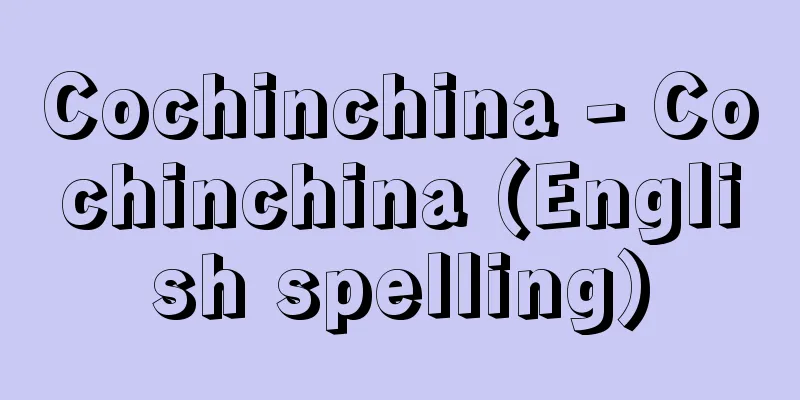Cochinchina - Cochinchina (English spelling)

|
The Chinese characters for this place name are "Kochishina", but the geographical area covered by this name varies with the era. It is believed that the origin of the name dates back to the early 16th century, when the Portuguese advanced into the Far East, and since Vietnam's old name was Kochi, they began to use the name to distinguish it from Cochin, a Portuguese territory in India. It initially referred to North Vietnam under the rule of the Lê dynasty. In the early 17th century, when the conflict between the Trần and Nguyễn clans began, Cochinchina came to refer to central Vietnam under the control of the Nguyễn clan, and as the Nguyễn clan's influence moved southward, it came to refer to South Vietnam as well. The area covered by this name corresponds roughly to the "Guangnan Kingdom" that Chinese merchants in the Ming and Qing dynasties referred to, and the "Koji Kingdom" or "Kawachi Kingdom" that Japanese red seal ship merchants referred to. In contrast, North Vietnam under the power of the Trinh Dynasty was called "Tokyo (Tonkin)" by Chinese and Japanese merchants, and Portuguese and Dutch merchants followed suit and called it Tonkin. From the 1980s, when France exercised its protectorate over Vietnam under the Nguyen Dynasty, the north of Vietnam came to be called Tonkin, the central part Annam, and the south Cochinchine, and together with Cambodia and Laos, Tonkin became a protectorate, Annam a protectorate, and Cochinchine a colony, forming French Indochina. Thus, throughout the French period (1887-1945), Cochinchine (Cochinchina) referred exclusively to South Vietnam. [Chen Jinghe] Source: Shogakukan Encyclopedia Nipponica About Encyclopedia Nipponica Information | Legend |
|
漢字では「交趾支那(こうちしな)」をあてるが、この地名がさす地理的範囲は時代によって異なる。その起源は、16世紀初めポルトガル人が極東に進出したのち、ベトナムの古名が交趾(こうち)であることから、インドのポルトガル領コーチンCochinと区別するために使い始めたものと思われ、当初は黎(れい)朝治下の北ベトナムをさした。17世紀初年、鄭(てい)、阮(げん)両氏の対立抗争が始まると、コーチシナは阮氏の支配するベトナム中部をさすようになり、阮氏勢力の南下に伴い、南ベトナムをも含めてさすようになった。その範囲は、ほぼ明(みん)・清(しん)時代中国商人のいう「広南国」、日本御朱印船商人のいう「交趾国」または「河内(こうち)国」にあたる。これに対して、鄭氏勢力下の北ベトナムは中国、日本商人から「東京(トンキン)」とよばれ、ポルトガル、オランダの商人もこれに倣ってトンキンとよんだ。19世紀の80年代からフランスが阮朝治下のベトナムに対する保護権を行使するに及び、ベトナム北部はトンカンTonkin、中部はアンナムAnnam、南部はコシャンシーヌCochinchineとよばれるようになり、トンカンは保護領、アンナムは保護国、コシャンシーヌは植民地として、カンボジア、ラオスとともにフランス領インドシナを形成することとなった。こうして、フランス時代(1887~1945)を通じてコシャンシーヌ(コーチシナ)はもっぱら南ベトナムをさした。 [陳 荊 和] 出典 小学館 日本大百科全書(ニッポニカ)日本大百科全書(ニッポニカ)について 情報 | 凡例 |
<<: Charadrius dubius; little ringed plover
Recommend
Poudreuse
… Small mirrors were used as dressing mirrors, ei...
Weeds - Weeds
Weeds are unwanted plants, especially herbaceous ...
Sakuragicho Incident
A train fire occurred at Sakuragicho Station in Yo...
Macroevolution - Daishinka (English spelling) macroevolution
This refers to the process of forming a lineage o...
Kakko Dance - Kakko Dance
〘Noun〙 A type of folk performing art. A group of p...
Cobalt Oxide - Sanka Cobalt
[ I ] Cobalt oxide(II): CoO(74.93). Obtained by h...
Ikawa Dam - Ikawa Dam
(Aoi Ward, Shizuoka City, Shizuoka Prefecture) A t...
Cenodoxus (English spelling)
…Jesuit theatre often performed martyr plays with...
Aksharakara - Aksharakara
...The original meaning is "palm" or &q...
Diaphragmatic breathing
…When the diaphragm relaxes, the dome rises upwar...
Brittleness
… In contrast to ductility, when an object such a...
Kiritanpo
A local dish from Akita Prefecture. Non-glutinous...
Hiirotake (Scarlet Mushroom) - Hiirotake (English spelling) Trametes sanguinea
Basidiomycetes, order Aphyllosteganales, family Po...
Archetype - Genkei
Archetype : A Jungian term. A psychic structure th...
Kirikamuro
...A large piece of Satsuma-mono. It is a reworki...






![Kajiki [town] - Kajiki](/upload/images/67cb326a440b0.webp)


